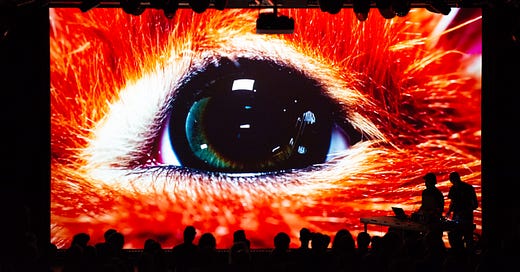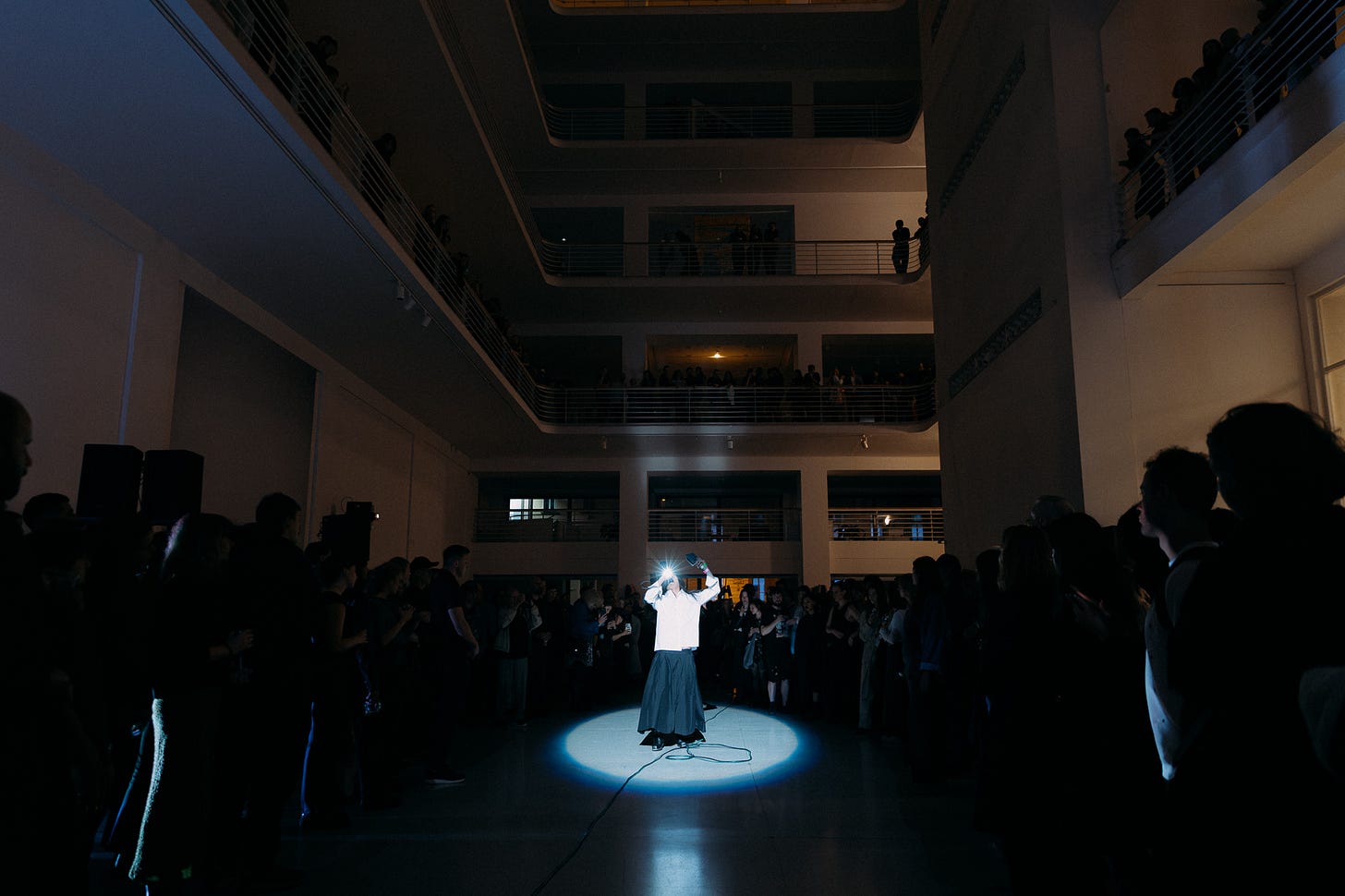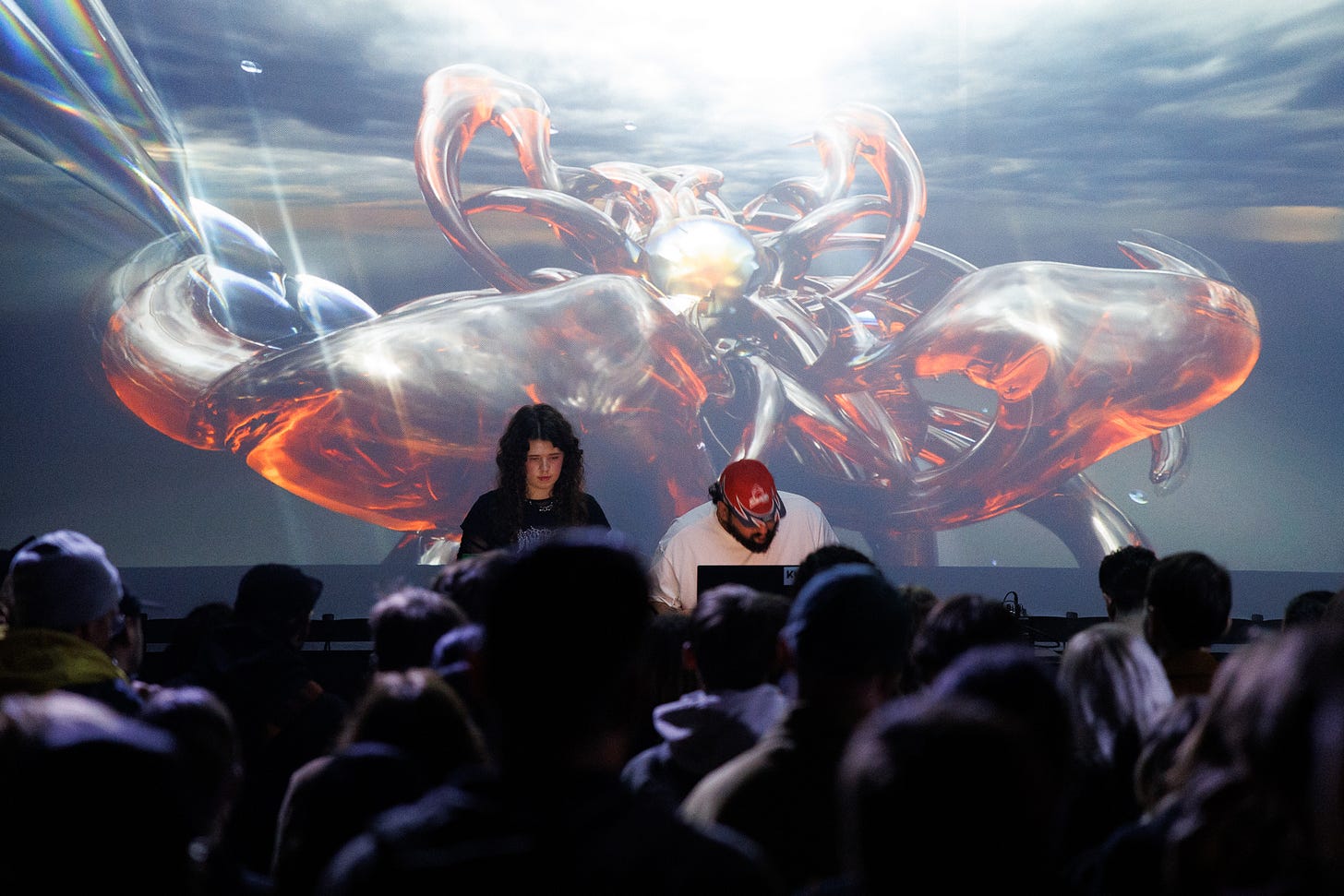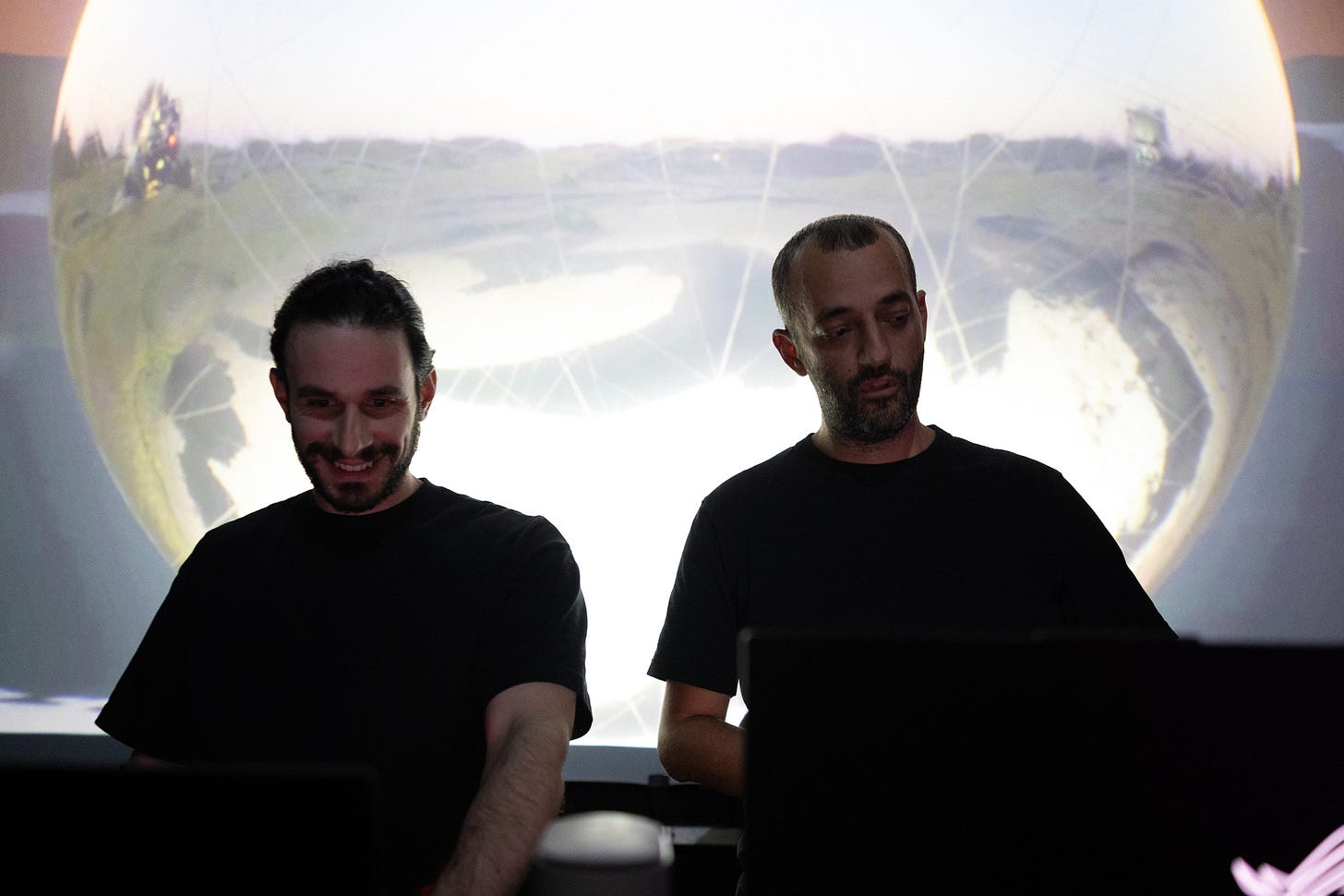Lunchmeat Festival, Prague 2024
Two weeks after the fact, the highlight performances from Lunchmeat Festival are still resonating. Here's my list, and some words about the festival as a whole.
In 2020, I quit my marketing job in order to come to Lunchmeat Festival in Prague. A couple of weeks later, I had moved to Czechia, and within the year I was working for the festival. Lunchmeat is very close to my heart, as a result, and this was the fifth consecutive edition I attended, making it the biggest blip in my festival heatmap.
The first three times or so I came to the festival I wrote lengthy reviews — the first review was split into two articles of about 2,000 words each. These reviews were honest representations of the events, but also fall into the category of “media partnership reviews”, which are inherently biassed: ask any (decent) staff writer and they’ll talk about the moral difficulty of balancing factual reporting and praising the festival.
This year I’ve got my own platform to write on, and no editorial guidelines to restrict my words, which means I’m going to give a personal review of my favourite experiences of Prague’s greatest underground music festival, with a little self-review and recollection of the three panel discussions I held, before we get back to the typical programming of reviews and playlists — and there’s so much great new music to catch you up on!
This year was Lunchmeat’s 15th edition, and anyone who’s been attending for at least as long as I have will be familiar with the format of the festival: three opening concerts in a different venue every night, and three “main nights” of the festival that start early evening and end early the next morning.
There were some changes this year, and I welcome them: first, the ballistic damage of a week-long drinking marathon (in Eastern Europe no less) was lessened significantly by Ankali lowering the pressure of their annual Wednesday event to a ‘Shoes Off’ cosy evening; second, Thursday’s welcoming event was over before 2am, and though the festival stretched out onto Sunday evening, it finished around 1am; finally, the programming was excellently managed, granting a clear narrative arc to the performances that didn’t demand superhuman energy to witness.
These together meant a more comprehensible and enjoyable experience for someone whose hell-bent party days are gradually tapering away. This was supported by a free outdoor stage that ran from 4pm Thursday - Sunday, which played host to some great sets, my personal fave being Tokyo’s Lil Mofo, who played a brilliant selection of dub reggae 7”s to blow clear a gloomy sky. It was a challenge to get the motor running by 4pm, and actually enjoy the music once there, but personally this was a much easier task than keeping it running past 4am.
Still, when you compare Lunchmeat Festival to others in Europe, the daytime still feels a little bare. On one hand, you’re left to explore some of Prague (or, if you’re local, nurse hangovers in bed), but on the other there’s not much included in the ticket that occupies you during the day. The flipside of this is that you’re not carting yourself across the city hunting for concerts, performances, or the last free corner in a listening room somewhere, which was a major critique I had of CTM Festival 2023.
Lunchmeat Festival definitely gets a huge amount right, and pricing is one of these areas: this year you could get a 4-day festival pass for just over 60 EUR, which is crazy in today’s economic cesspit. It’s not budget thrills either; the lineup is stacked with high-end, top-scale acts, including many world premiere performances, and the locals you may not be familiar with always punch well above their weight in terms of artistry, delivery and ethos. Given the price of CTM or Atonal, with additional outgoings for accommodation and food in Berlin, I really don’t understand why this festival isn’t on more people’s to-do lists. You can have a nice long weekend in Prague for less money than housing yourself for a week in most of Western Europe.
Photo by Kuba Dolezal
The festival started with a performance from Gryvul and Guevara, amongst my most anticipated, as it deals specifically with Gryvul’s emotions (as a Ukrainian) regarding the re-emergence of the Russo-Ukrainian conflict in 2022. It’s a grim, dour topic, an important one, and I was curious to see the realisation of it on a 20x5m projection screen, but ultimately I was left wanting.
Gryvul’s musicianship was on fair display, and she coursed through a wide range of styles and depth; however, at one hour long, I felt the performance overused repetition in order to meet the runtime. Ideas that could have worked well as interstitial frames or transitional sequences became 5-7 tiring minutes, contributing to the performance feeling a little overdone at 60 minutes; the introductory sequence featured bomb-blasts of light within gathering smoke, but the impact of the sequence became quite pale at the end. The visual component may have had something to do with this: Guevara scanned, scrolled, and scrambled through a particle-based 3D digital installation, but it was a very abstract visualisation, heavily repetitive (and sometimes, frankly, dull), and more often than not I found myself detached from the reality the performance intended to evoke.
The following night, INFERNO at Archa+, had me scratching my head for a while also, but ultimately I reflect on it a little more positively in hindsight. It’s hard to fully describe in words: a group of participants get strapped into a robotic exoskeleton of sorts that utterly controls the movement of the arms and shoulders. The performance involves watching these people get moved about “against their will” to some pretty rudimentary techno. This itself was not really all that interesting for me, although watching the pneumatic details of the suits is certainly cool for a while.
But, while I didn’t really enjoy the performance aspect, the idea of the perform-installation (?) eventually stuck to me. See, the performance was called INFERNO due to association and inspiration from Dante’s inferno; it wasn’t about being a surface-level cool robot trick, or a cutting-edge demonstration of techno music, but a conceptual piece about repetition, copycat behaviour and social conformity. A few times the music kickstarted with big boomy kicks, but the “dancers” wrapped in the hardware were left unmoved by their prostheses. The look of fear on their faces before the machines powered on — “oh, something has gone terribly wrong, there’s music playing but I’m not dancing!” — drove that point home, with a smile. Even Hell has humour.
Wednesday saw Journalist Freddie kicking into gear, as I was fortunate to be invited by Gravity Network and Ankali to interview an old friend, Rebecca Salvadori. Me and Rebecca met in 2019 when we both played a part in the creation of ‘Desert Rave’, her film, and a written review by me, about a one-shot festival in Morocco. Since, Rebecca’s been recognised as a sensation in electronic music, and has been commissioned multiple times to make films about aspects of underground electronic music culture. Her films ‘The Sun Has No Shadow’ and ‘Messengers’ were shown, and then I asked a few questions to try to uncover her processes.
Photo by Kuba Dolezal
I took a great amount of personal joy in the films: TSHNS is a love letter to London nightclub FOLD, which I was a regular at while I lived in the city, and Messengers includes many sections shot at PAF in Olomouc, Czechia, and the film opens with the Czech language and shots of typical Czech architecture. The two films, seen together, had a special resonance for me in that they could almost be a shadow narrative on my own life of the last 8 years.
I have to confess it’s hard to recall precise memories of the interview after a festival of heavy drinking, but recollections emerge from my notes: Rebecca was very clear that her current popularity as an artist and filmmaker came after many many years of hard work with no audience; after finding a break, her work has been respected thanks to the inherent quality that comes as a result of long effort; tropes within her work, such as her use of subtitles (which do not necessarily reflect the audible spoken content), or the ‘Euroemptiness’ series of graphic symbols used in TSHNS, evolved naturally, largely through exhibiting her films in a live setting.
A constant awareness of personal goals within her artistic practice underpins all of what she does. This allows Rebecca to be very clear about what the output will be when it comes to accepting commissioned work, and also allows her to steer public perception of her work by accepting only work that furthers her goals. Privately, before the screening, we discussed notable outliers — nothing’s ever perfect — but Rebecca has taught me that being clear with your personal goals allows you to be more rigorous with agreeing to the right work, and that this also contributes towards a better standard of self-selection from the side of the commissioning party.
From this point the festival stooped into its typical pattern, a fugue state of bewilderment and stunning art. Thursday’s events opened with South Korean artist bela performing their ‘Noise and Cries’ audiovisual performance live. If you’ve caught them before then you’ll know what to expect: guttural screams, a mysterious little book, a flashlight glaring into your eyes. I’d caught bela at CTM festival in 2023 and this set felt like a precisely considered next step. The physical theatre elements of the performance were enhanced through a portable rig of a speaker, camera and effects unit, allowing bela to charge through the space with more gravitas and authority; every step taken carried audience’s gaze, glued to the spectacle.
Photo by Kuba Červenka
The following morning I had the last of my business duties at the symposium: first, an interview with Jef Oswald of Yuku and Jan Macháček of UNIZONE about running a label in Czechia; second, an interview with two paired acts Pinch & Lorem and object.blue & Natalia Podgórska, I aimed to uncover the process of the creation of their performances, and how the music and visual art were layered to create something cohesive.
The first talk went smoothly, and the learnings were quite applicable outside of the Czech scene: stay true to your vision of the label, while allowing it to grow and shape itself; follow the artist’s direction as closely and faithfully as possible; don’t chase the likes, and let your audience magnetise towards you (even if it takes longer, the rewards are richer).
What was interesting for me was a general lack of moaning about coverage outside Czechia with platforms like Resident Advisor: it seems UNIZONE mostly struggle with press inside their home territory (reportedly due to a lack of journalistic platform, and therefore also missing a language framework, to address their music), while Yuku maintained that external coverage happens, but it’s impossible to predict the outcome — regardless of funds spent on press (Jef stressed that this wasn’t a fault levelled at their PR agent, but at the unpredictability of the industry) — so they’ve stopped caring, in order to enjoy the process of running the label once again.
It’s always a little nerve-wracking to host panels with “international” musicians and artists (especially when two of them, Pinch and object.blue, have been very instrumental in my developing music taste). I attempted to balance the questioning between the two pairs of performers, and let narratives emerge, which they did, to an extent.
Firstly, both pairs worked very loosely with themes borrowed from dream research, albeit from totally different angles and very different depth: Lorem, who presented an A/V show at Lunchmeat in 2022, has trained a machine-learning visual art model using an extensive 20-year dream diary, and the performance with Pinch directly referenced an early guide to lucid dreaming (which may or may not be related to this album, anecdotally), while object.blue and Natalia’s ‘Ghosts’ performance took only its name, from an adage that therapy lets you communicate with the living once again, allowing you to stop talking with “the ghosts of the past.”
Secondly, both pairs created their performance with acts or chapters: Pinch and Lorem’s ‘A Red Rabbit’ was very narrative-oriented, with near-film sequences, and an abstract yet clear development of plot; object.blue worked in chapters in order to slow the typically frenetic pace of her live improvised sets, where all the material is burned through in a short span of time.
It was really illuminating talking to the four artists, even if it was a small challenge to fully engage with each of them in order to keep the conversation moving fluidly, and during the performances I definitely felt like I had a little insider knowledge.
Photo by eLi
Later, we got to enjoy their performances: object.blue and Natalia played first, and swiftly had me thinking it was the finest performance of the festival yet, thanks to the tumbling syncopation of drums and an engaging exploration of the ever-evolving world inside Natalia’s laptop. Very sadly, the performance was cut short as object.blue’s laptop continually crashed, but, even stood in the middle of the floor as it slowly dissipated away, before time and disappointed but understanding, the spectacle which we did see was untarnished.
Pinch and Lorem followed immediately afterwards, like climbing back onto the bike after a fall. Lorem’s visuals were absolutely stunning, hyper-high-definition close-ups and an excellent balancing of AI’s “uncanny valley” mode of realism, and Pinch’s music was excellent, and expectedly unexpected — in the interview he divulged that people would recognise aspects of the music he’d prepared, but it wasn’t going to be an exact realisation of music we already knew from him.
I said many times in the hours and days afterwards that it was the type of performance I was always hoping for from my older dubstep-era heroes; with no particular fixation on (or fetishisation of) BPM or style, his qualities as a musician shone bright. The set felt like the kind of thing I’d expect to see people chatting about excitedly after CTM or Atonal; sharp, refined, emphatic.
The rest of Friday’s lineup was completely packed with must-see performances: local band End Society’s driving, bassy songs reminded of Mezzanine-era Massive Attack; Slovak multidisciplinary artist Boris Vitázek absolutely stunned with a solo A/V show, ‘Narrative Absence’, that cleverly toyed with themes of cliché, repetition and empty storylines; Shanghai native 33EMYBW (which I am told can be more conveniently pronounced '“Sen Sen”) and visual artist Joey Holder wrought a dramatic, syncopated percussive heaven in vivid green, studded with insect armour and emblazoned with symbolism borrowing from the ancient and the arcane. I couldn’t stick around to enjoy the DJ sets from KAVARI and Exhausted Modern and Domizako, but my quota for quality music had been completely satisfied.
Photo by Kuba Dolezal
Saturday began with a much-anticipated live performance from timmi, a devotional music specialist based here in Prague, who demonstrated a truly radiant voice, and continual development in their personal line of musicality that combines light synthwork with traditional acoustic instruments such as the shruti box. Next, Myriam Bleau & Nien Tzu Weng from Montreal delivered a quite stirring physical theatre performance interrogating the phenomenon of online identity using pillars of interactive LEDs, and wearable prostheses.
The performances from Toumba & Sida100 and ABADIR & Nicolò Cervello were otherworldly in quality, and represented for me the pinnacle of artistry at the festival. Toumba was first, with an evident level-up for the Jordanian’s musicianship: aspects of his released work for Hessle Audio or Nervous Horizon could be heard in the rapid rhythmic percussion and Arabic music samples, but it was delivered to a new standard — or perhaps a new value system.
There was energy and pulse, but it was not the goal of the set; my favourite sequence of danceable music lasted about 4 bars before devolving, re-developing and advancing thematically. I believe it was his debut live performance, and it was truly excellent. Sida100’s visuals were an excellent pairing: like the music, the visuals also evolved, instead of fixating and stagnating, and the palette was bright, organic and airy, a perfect match for the carefully considered music.
Photo by Kuba Dolezal
This serves as an excellent bridge to ABADIR’s absolutely jaw-dropping live performance, which perfectly (again, perfectly) balanced the power and emphasis of his sound design from the PAUSE/STUTTER/UH/REPEAT album era, his focussed, exact ambient sound design, the conceptual venturings of his experimental works and the pummelling heft of his club music. It felt like the culmination of all his music to date.
The course changed rapidly, like Toumba’s set, with some of my favourite moments lasting for a bright, brief second. Each of the six or seven movements were opened with vastly textured sonic images which seemed to explode with initial energy, before decaying gradually into ambient radiance. Cervello’s hyperactive playful universes similarly exploded and popped with odd everyday items, glistening fabricated illusions, and expansive, gorgeous landscapes, a perfect match for the conceptual and ideological themes in ABADIR’s music: be playful, be fun, but with intention to make serious and well-developed art.
Photo by Romana Kovacs
The final day was a haze for me, despite just a small handful of acts to catch, but there’s just enough space left at the bottom of this review to talk about GBClifford, who I was quite curious about thanks to a buzz from other locals who’ve seen their performance before. Tying together main-character stage magnetism with experimental-leaning production, the show balanced bright limelight with a dark, emotional undertow. Perhaps my favourite aspect of the performance was the atmosphere crafted by Lunchmeat’s Tasya, who seemed to completely command light and smoke to exemplify the drama of the songs and the arresting physical presence of GBClifford. It was rare to see such careful attention in crafting an experience that wasn’t focussed solely on the main performer, but rather on the ambient state of the room itself.
This year’s festival really stood out for me as an excellent edition, and I hope to see a continuation of the best new developments in the coming years. If you’ve not made it, I can genuinely recommend it as one of the finer city-bound festivals I’ve been to in Europe. Over 15 years, the festival has made a commensurate impact on the fabric of Prague’s nightlife: audiovisual experiences are commonplace, and Lunchmeat is always one year away, creating a seasonal cycle of artistic development and progression. This makes itself felt strongest when acts like GBClifford and timmi — and the local visual artists paired with international stars — come to the stage and show the city how they have grown.
I hope you enjoyed reading this (actually rather stringent) review of Lunchmeat Festival! Reach will be back soon with the regular(?) broadcasting of albums and new tracks.











